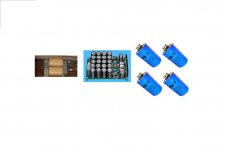Hi,
Yes, reasoning audible distortion at 20Hz, I agree with you.
but you see the problem from another point. (1) th3% and apparent noise (ondulations) is due to oscillation from psu vcc. woofer is moving after bass sound.
(2) If I develop a good amplifier with integrated PSU, I can not provide this curve of THD (and then say you do not hear).
We have done tests with traditional PSU (+ /-60V with 2x4700uF). Th1-TH6 from 10Hz up to 30kHz is flat on this Class D amplifier.
This SMPS but with testing mospower class a-b. in this case, the THD is flat. (after put curves).
last problem is on IMD amplifier. this has enormous influence that must have audiophile amplifier performances. Sure... it works.
ok, I just want to show that you can replace the psu with SMPS if this is really designed for audio amplifiers.
This implies several things about SMPS circuit and not as some would say simple precautions.
Yes, reasoning audible distortion at 20Hz, I agree with you.
but you see the problem from another point. (1) th3% and apparent noise (ondulations) is due to oscillation from psu vcc. woofer is moving after bass sound.
(2) If I develop a good amplifier with integrated PSU, I can not provide this curve of THD (and then say you do not hear).
We have done tests with traditional PSU (+ /-60V with 2x4700uF). Th1-TH6 from 10Hz up to 30kHz is flat on this Class D amplifier.
This SMPS but with testing mospower class a-b. in this case, the THD is flat. (after put curves).
last problem is on IMD amplifier. this has enormous influence that must have audiophile amplifier performances. Sure... it works.
ok, I just want to show that you can replace the psu with SMPS if this is really designed for audio amplifiers.
This implies several things about SMPS circuit and not as some would say simple precautions.
Last edited:
Hi,
Yes, reasoning audible distortion at 20Hz, I agree with you.
but you see the problem from another point. (1) th3% and apparent noise (ondulations) is due to oscillation from psu vcc. woofer is moving after bass sound.
(2) If I develop a good amplifier with integrated PSU, I can not provide this curve of THD (and then say you do not hear).
We have done tests with traditional PSU (+ /-60V with 2x4700uF). Th1-TH6 from 10Hz up to 30kHz is flat on this Class D amplifier.
This SMPS but with testing mospower class a-b. in this case, the THD is flat. (after put curves).
last problem is on IMD amplifier. this has enormous influence that must have audiophile amplifier performances. Sure... it works.
ok, I just want to show that you can replace the psu with SMPS if this is really designed for audio amplifiers.
This implies several things about SMPS circuit and not as some would say simple precautions.
You haven't proven cause. If anything, should we be given to trust these measurements, you've proven that in fact simple precautions are all that's required, since according to your own findings merely having the same supply in integrated form -- thereby enjoying a tighter layout and cleaner ground structure, resolves the issue entirely. Rather than bring that simple fact into light however, you instead show up with a product to sell.
Also, did you take those measurements with a soundcard? What type of supply was it powered by? Should we just trust your measurement setup that we cannot see?
The only thing wrong with that kind of a supply is the weight should you have to carry it around with you. It's never "that simple", the skill with which you implement it, be it switch mode or otherwise, can easily be the deciding factor, unless you start with pure trash.
It seems this marketed SMPS could be load variant, but can it keep up, can it step up and down cleanly, how does the EMI profile change with load, and what good is it but to claim that extra few percent in efficiency, Or save that extra dollar in components? Was it really designed for music, or is its design only good for music. RIP.. Sometimes simple and robust is the superior solution.
...............
Are we forgetting SS regulated supply.......expencive, but maybe worth it
http://www.diyaudio.com/forums/class-d/164442-regulated-supply-does-make-sense.html
Attachments
I answered at beelde.
I'm sorry but I did not understand your question.
Im asking you to create a thread dedicated to your designs
Would be much better, and in favour of all members

Im asking you to create a thread dedicated to your designs
Would be much better, and in favour of all members

Hi Tinitus,
yes I remember this,I find some time to prepare documentation.
Regards
- Status
- This old topic is closed. If you want to reopen this topic, contact a moderator using the "Report Post" button.
